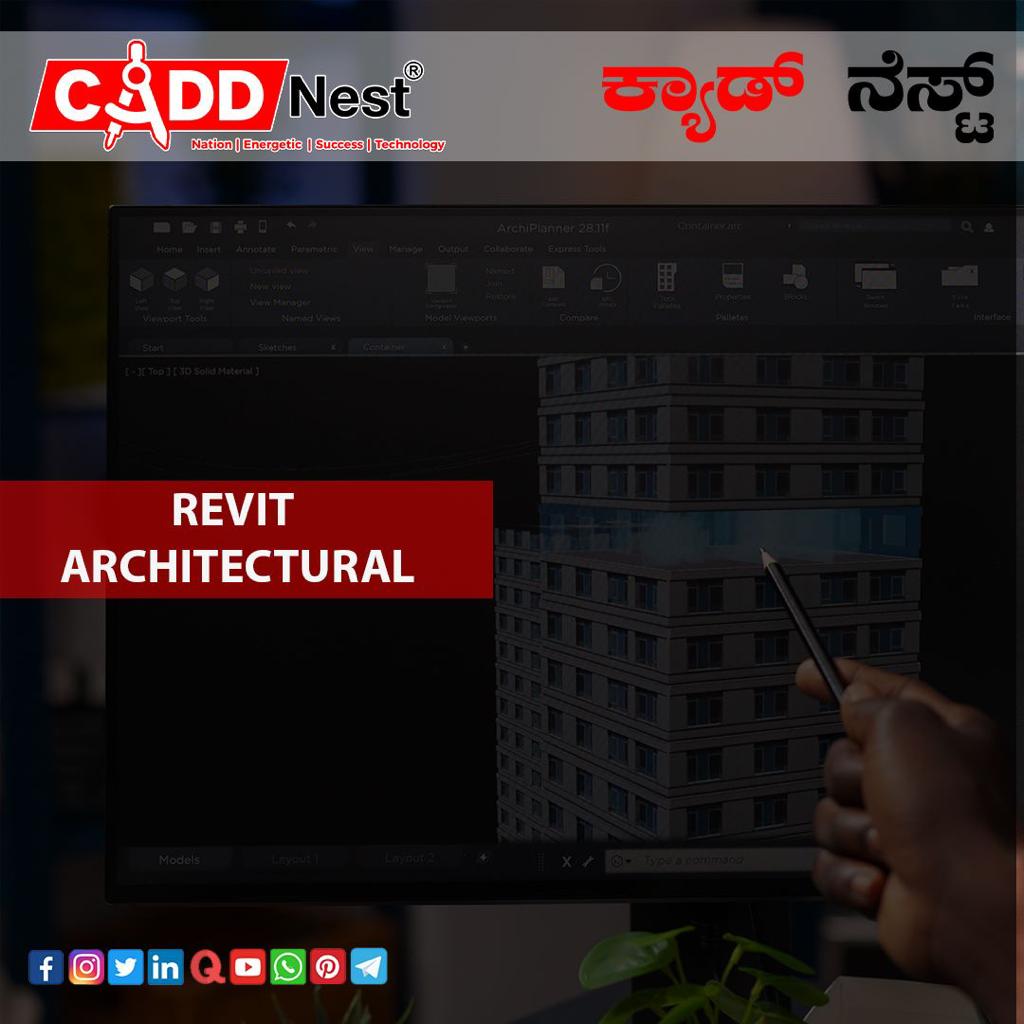The Rise of Revit: Transforming Architecture with Technology

Introduction
Revit architectural software has revolutionized the field of architecture, bringing technology to the forefront of the design process. With its advanced features and capabilities, Revit has empowered architects to create stunning, innovative structures that were once only imaginable. The use of this cutting-edge software has become increasingly prevalent in the industry, allowing architects to push the boundaries of design and construction. At the forefront of Revit education is CADD Nest Institute, an institution dedicated to unlocking the potential of this powerful tool and preparing aspiring architects for a successful career in the field.
Understanding Revit Architectural Software
Evolution of Architectural Design Software
Over the years, architectural design software has evolved, transitioning from traditional 2D drafting to the more sophisticated 3D modeling prevalent today. Revit stands out as a game-changer, offering an integrated platform that combines 2D drafting and 3D modeling, allowing architects to bring their designs to life in a virtual environment.
The Basics of Revit: Interface and Tools
Revit provides a user-friendly interface, making it accessible to designers of all experience levels. Its intuitive tools enable architects to create detailed models, generate construction documents, and develop accurate cost estimates.
BIM (Building Information Modeling) in Revit
One of Revit’s key features is its ability to facilitate Building Information Modeling (BIM). BIM allows architects to digitally represent the entire architectural project, including the structure, materials, and building systems. This integrated approach enhances collaboration and streamlines the design and construction process.
Collaboration and Coordination Features
Revit excels in facilitating collaboration among team members, enabling real-time communication and coordination. Its cloud-based approach ensures that all stakeholders have access to the most up-to-date information, reducing errors and improving overall project efficiency.
Adaptability and Customization in Revit
Revit offers a high degree of adaptability and customization, allowing architects to tailor the software to their specific needs. From creating custom families to developing unique design strategies, Revit empowers architects to push the boundaries of their creativity.
Overview of Revit’s Benefits
Enhanced Design Efficiency with Parametric Components
Revit’s parametric components enable architects to make design modifications easily and efficiently. These components ensure that changes made to one aspect of the project automatically update related elements, reducing time and effort.
Accurate Documentation and Consistent Updates
Revit’s integrated documentation capabilities ensure accuracy and consistency throughout the design process. Any modifications made to the model are reflected automatically in all associated documentation, minimizing errors and discrepancies.
Seamless Analysis and Visualization Capabilities
Revit’s built-in analysis and visualization tools provide architects with a comprehensive understanding of the design’s performance and aesthetics. From energy analysis to daylighting simulations, Revit empowers architects to make informed decisions and create sustainable structures.
Improved Communication and Coordination among Team Members
Revit’s collaboration features foster effective communication and coordination among architects, engineers, and other project stakeholders. By developing shared models, team members can easily identify clashes or conflicts, leading to quicker resolution and smoother project execution.
Cost and Time Savings through Automated Processes
Revit’s automation capabilities significantly reduce project timelines and costs. From generating accurate quantity takeoffs to automating repetitive tasks, Revit enables architects to focus on innovation and design rather than tedious manual work.
Exploring Revit’s Key Features
3D Modeling and Visualization
Revit’s robust 3D modeling capabilities allow architects to create detailed, realistic representations of their designs. From intricate building elements to lifelike rendering, Revit brings designs to life, aiding in visualization and communication with clients and stakeholders.
Parametric Design: Empowering Architects
Revit’s parametric design approach enables architects to create intelligent, flexible models that adapt to changes. By establishing relationships between elements, architects can modify one aspect of the design, and the entire model adjusts accordingly, enhancing design flexibility and efficiency.
Intelligent Object Libraries and Libraries Management
Revit’s vast object libraries offer an extensive range of pre-built components, including furniture, fixtures, and materials. Architects can easily access these objects and customize them, saving time and effort in the design process.
Analysis and Simulation Tools
Revit’s analysis and simulation tools provide architects with valuable insights into the performance of their designs. From structural analysis to energy efficiency simulations, these tools empower architects to optimize their designs for functionality and sustainability.
Collaboration and Coordination Features: Constructability, Clashes Detection
Revit’s collaboration and coordination features allow architects to work seamlessly with other team members. By detecting clashes and conflicts, Revit ensures that potential issues are resolved before construction begins, reducing costly rework.
Design Options and Iterations: Efficient Decision-making
Revit’s design options feature enables architects to explore multiple design iterations quickly. From experimenting with different materials to testing alternative configurations, Revit empowers architects to make informed design decisions efficiently.
The Role of Revit in the Architectural Design Process
Conceptual Design: Exploring Creative Possibilities
Revit plays a vital role in the conceptual design phase, where architects explore various creative possibilities to develop a design vision. With its intuitive 3D modeling tools, architects can quickly visualize and refine their ideas.
Schematic Design: Translating Ideas into Reality
During the schematic design phase, architects use Revit to translate their conceptual ideas into tangible design proposals. Revit’s parametric design capabilities enable architects to iterate and refine their designs, ensuring that the final proposal meets the project requirements.
Design Development: Refining and Detailing the Project
Revit’s robust documentation features come into play during the design development phase. Architects can produce detailed construction documents, including plans, sections, and elevations, providing the necessary information for the construction team to bring the design to life.
Construction Documentation: Streamlining the Output
Revit significantly streamlines the production of construction documentation, enabling architects to generate accurate and comprehensive sets of drawings. Automatic updates ensure that changes made to the model are reflected immediately, reducing the risk of errors and inconsistencies.
Post-Construction: Maintenance and Facility Management
Even after the project is completed, Revit continues to play a crucial role in facility management and maintenance. With Revit’s intelligent modeling capabilities, architects can create comprehensive and accurate facility management models to aid in ongoing operations and maintenance.
CADD Nest Institute: Empowering Architects through Education
Industry-Driven Learning Environment
CADD Nest Institute provides an industry-driven learning environment that prepares aspiring architects for the challenges of the profession. With a focus on practical skills and real-world applications, the institute equips students with the knowledge and expertise needed to succeed in the architectural industry.
Expert Faculty and Comprehensive Course Offerings
At CADD Nest Institute, students learn from industry experts who possess extensive knowledge and experience in Revit and architectural design. The institute offers a comprehensive range of courses, covering various aspects of Revit, ensuring that students receive a well-rounded education.
Specialized Training in Revit Software
CADD Nest Institute specializes in providing in-depth training in Revit software. Students acquire hands-on experience with the software’s key features and learn how to apply them effectively to real-world architectural projects.
Hands-on Projects and Real-World Application
CADD Nest Institute emphasizes hands-on learning by incorporating projects that simulate real-world architectural design challenges. Through these projects, students gain practical experience and develop the skills necessary to tackle complex architectural projects.
Career Advancement Opportunities
CADD Nest Institute goes beyond providing technical skills; it also offers career advancement opportunities. The institute assists students in developing their professional portfolios, connecting with industry experts, and accessing job placement assistance programs to kickstart their careers.
Benefits of Joining CADD Nest Institute
Pristine Learning Experience: State-of-the-Art Facilities
Students at CADD Nest Institute benefit from state-of-the-art facilities, including well-equipped computer labs and dedicated spaces for hands-on training. These facilities create an optimal learning environment, enabling students to make the most of their educational experience.
Personalized Attention and Mentoring
CADD Nest Institute believes in providing personalized attention and mentoring to each student. With small class sizes, students receive individual guidance and support from faculty members, fostering a conducive learning environment.
Industry Certification and Recognition
CADD Nest Institute offers industry-recognized certifications upon successful completion of its courses. These certifications validate students’ skills and enhance their employability by demonstrating their competence in Revit software and architectural design.
Networking Opportunities
Joining CADD Nest Institute opens doors to valuable networking opportunities. Students have the chance to connect with industry professionals, attend workshops and seminars, and join alumni networks, facilitating career growth and professional development.
Conclusion
The Power of Revit Unleashed: Innovating Architecture
Revit’s powerful features and capabilities have revolutionized the field of architecture, empowering architects to push the boundaries of design. Its parametric design approach, collaboration features, and automation capabilities enhance efficiency, accuracy, and creativity in architectural projects.
CADD Nest Institute: The Gateway to Success
For aspiring architects seeking to unleash the full potential of Revit software, CADD Nest Institute provides the necessary knowledge, skills, and guidance. With its industry-driven curriculum, expert faculty, and state-of-the-art facilities, the institute prepares students for a successful career in the architectural industry.
Frequently Asked Questions (FAQs)
Is Revit software suitable for both small and large projects?
Yes, Revit software is suitable for projects of all sizes. Its scalability and adaptability make it a versatile tool that can handle projects ranging from small residential buildings to complex commercial structures.
What are the prerequisites for joining CADD Nest Institute?
There are no specific prerequisites for joining CADD Nest Institute. However, a basic understanding of architectural design principles and familiarity with computer-aided design (CAD) software would be beneficial.
How long does it take to complete the Revit program at the institute?
The duration of the Revit program at CADD Nest Institute varies depending on the course and the student’s prior knowledge. Generally, programs range from a few weeks to several months, providing comprehensive training in Revit software.
Can I pursue a career in architecture solely with Revit skills?
While Revit skills are highly valuable in the architectural industry, a comprehensive understanding of architectural principles and design concepts is essential. Proficiency in other software applications commonly used in the industry, such as AutoCAD, may also be advantageous.
How does CADD Nest Institute prepare students for industry challenges?
CADD Nest Institute prepares students for industry challenges through its industry-driven curriculum, hands-on projects, and exposure to real-world architectural scenarios. This practical approach equips students with the necessary skills and confidence to face the demands of the architectural profession.



